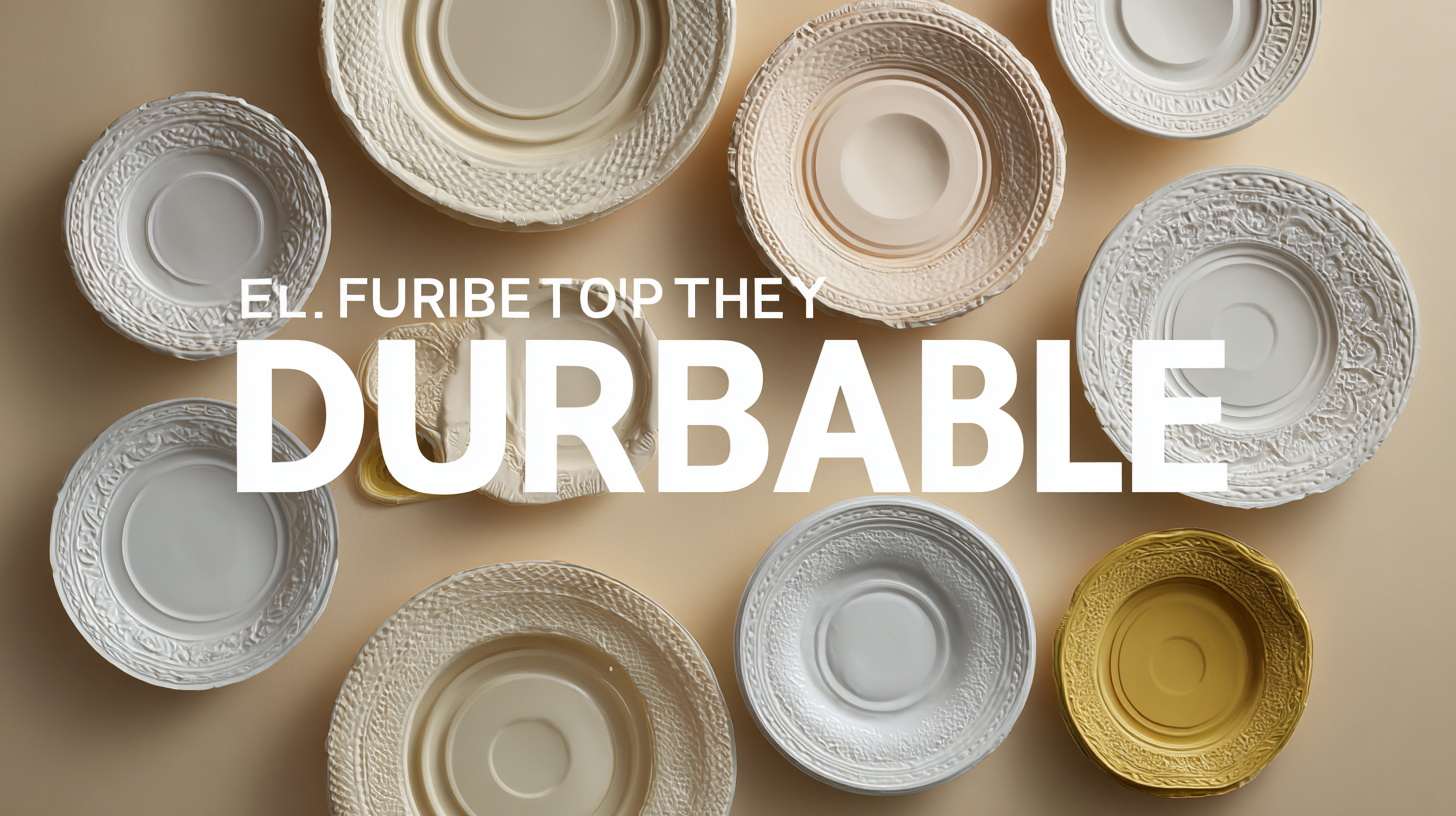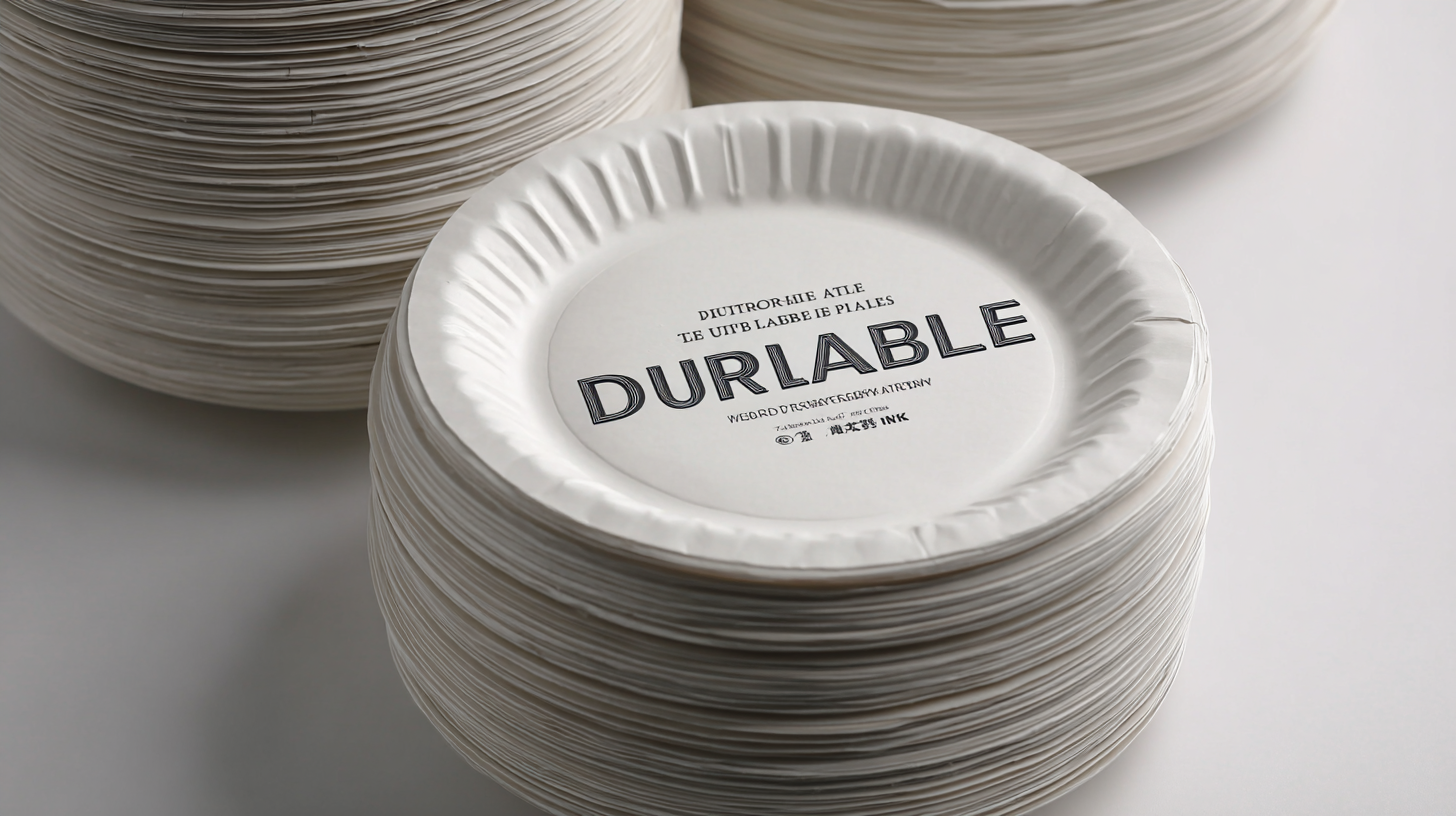Leave Your Message
As we look towards 2025, the disposable tableware industry is undergoing a transformation, particularly in the realm of "Durable Paper Plates." With increasing consumer awareness about sustainability and durability, the demand for high-quality disposable products is surging. According to a recent report by Smithers Pira, the global market for disposable tableware is expected to reach $16.5 billion by 2025, with an annual growth rate of 4.5%. This trend is not merely a response to immediate consumer needs but reflects a broader shift towards eco-friendly materials that offer strength without compromising on environmental responsibility. China's robust manufacturing capabilities are at the forefront of this evolution, driving innovations that meet both domestic and international standards for quality and durability. As the industry aligns with the mantra "中国制造,全球共享,品质值得信赖", the emergence of durable options, such as significantly improved paper plates, highlights a commitment to sustainability and consumer trust on a global scale.

The growing concern over environmental sustainability is propelling innovations in disposable tableware, particularly through the development of emerging materials that enhance durability without compromising ecological integrity. As we approach 2025, manufacturers are increasingly exploring bio-based plastics, which are designed to decompose more efficiently than their conventional counterparts. These materials not only provide greater strength and resilience but also reduce the environmental footprint, giving consumers an eco-friendly alternative for their disposable needs.
In addition to bio-plastics, advances in composite materials are revolutionizing the industry. By combining renewable resources such as bamboo fibers or sugarcane with recycled plastics, brands are creating tableware that is both sturdy and sustainable. This fusion allows for products that can withstand various conditions—from hot liquids to outdoor events—while maintaining a commitment to reducing landfill waste. As these innovations continue to surface, we can expect durable disposable tableware to become a staple in households, catering to both convenience and environmental consciousness.
As the demand for environmentally friendly products continues to rise, the debate surrounding biodegradable versus traditional disposable tableware has become increasingly significant. Traditional plastic tableware, while convenient, poses considerable challenges for the environment. These products often end up in landfills, where they can take centuries to decompose, contributing to pollution and harmful chemical leachage. In contrast, biodegradable options are designed to break down more quickly, reducing landfill burdens and minimizing persistent waste.
However, not all biodegradable materials are created equal. Some alternatives rely on compostable plastics, which require specific conditions to decompose effectively, raising questions about their true environmental benefits. In 2025, consumers will likely need guidance on distinguishing between genuinely sustainable options and those that merely claim to be biodegradable. Companies should consider transparency in their labels, offering clear information on the materials used and their environmental impact during production and disposal. As consumers become more environmentally conscious, the trend is towards tableware that not only meets the needs of convenience but also aligns with ecological responsibility.

In the quest for durability in disposable tableware, understanding user experience is crucial. As consumers become increasingly aware of the environmental impact and functionality of the products they use, manufacturers are innovating to meet these demands. Evaluating the strength and usability of disposable items is not just about the material used; it also involves how well these products perform during their intended use. Users are looking for tableware that can withstand heat, moisture, and weight, all while remaining environmentally friendly.
Market trends indicate that there is a shift towards sustainable materials that do not compromise on strength. Key players are exploring bioplastics and other innovative materials that promise durability without sacrificing user convenience. The user experience is enhanced when products are designed not only for short-term use but also to ensure they can hold up under real-world conditions. This focus on functionality and strength is shaping the future of disposable tableware, making it an essential consideration for both manufacturers and consumers as we look ahead to 2025.
The tableware industry is experiencing a significant shift towards sustainability, driven by growing consumer awareness and regulatory pressures. According to a recent report by Grand View Research, the global market for sustainable disposable tableware is projected to reach $26.98 billion by 2025, with a compound annual growth rate (CAGR) of 4.4% from 2019 to 2025. This growth is largely fueled by an increasing preference for eco-friendly materials such as bamboo, sugarcane, and recycled plastics, which are seen as viable alternatives to traditional polystyrene and plastic products.

Moreover, the rise of green consumerism is further influencing manufacturers to innovate their product lines. A market study by Smithers Pira indicates that 62% of consumers are willing to pay higher prices for sustainable products, highlighting the demand for disposable tableware that aligns with environmentally-conscious values. As brands respond to this shift, it’s evident that the future of disposable tableware will be characterized by enhanced durability while prioritizing sustainability, ultimately transforming consumer habits and business practices within the industry.
As we look towards 2025, the conversation surrounding the cost-effectiveness of durable disposable tableware becomes increasingly crucial. In an era of rising economic pressures, companies are under pressure to innovate, balancing functionality and sustainability without inflating prices. The trend is shifting towards products that not only minimize waste but also offer long-term savings through reusable options. This dual focus addresses economic constraints while recognizing the importance of environmental impact, particularly significant in regions like Africa where the socio-cultural landscape informs consumption patterns.
Additionally, stakeholders are increasingly considering the broader implications of their product choices. For instance, waste management strategies have evolved in response to resident feedback in places like Nelson Mandela Bay, showcasing a shift toward a more circular economy. As durable disposable solutions gain traction, they promise to reduce landfill contributions and mitigate the costly environmental consequences associated with traditional disposable items. This transformative approach not only redefines consumer habits but also proposes a sustainable model that harmonizes economic viability with ecological responsibility, paving the way for a greener future in disposable tableware.
| Material | Durability Rating (1-10) | Cost per Unit ($) | Recyclability (%) | Average Lifespan (Days) | Consumer Preference (%) |
|---|---|---|---|---|---|
| Bamboo | 8 | 0.15 | 90 | 30 | 75 |
| PLA (Polylactic Acid) | 6 | 0.20 | 70 | 20 | 65 |
| Sugarcane (Bagasse) | 7 | 0.10 | 95 | 25 | 80 |
| Plastic (PS or PP) | 5 | 0.12 | 40 | 15 | 50 |
| Palm Leaf | 9 | 0.25 | 100 | 40 | 70 |
